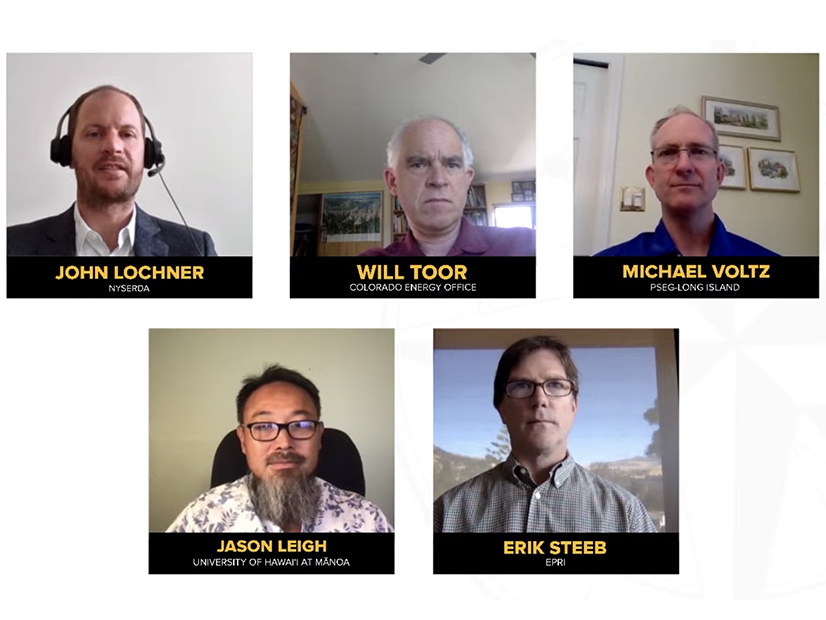Stony Brook University hosted its 11th Advanced Energy Conference this week to explore the potential for new technologies to speed the transition to a cleaner power grid for New York and the rest of the world.
“We all know the outsize risks of not decarbonizing, but from an execution perspective, how much of these decarbonization efforts and these government policies are just another set of government priorities, or is the execution actually something much grander in scale or scope than traditional public policy and traditional change within the utility sector?” asked John Lochner, vice president of the New York State Energy Research and Development Authority (NYSERDA), who moderated a panel on clean tech innovations and meeting near-term climate goals.
The Advanced Energy Research and Technology Center (AERTC) held the two-day virtual event ahead of a return to in-person meetings in September 2022.
Market Transformation
Decarbonization is much bigger than just government policy, said Erik Steeb, head of an innovation incubator at the Electric Power Research Institute (EPRI).
“In fact, if I look at the federal side, government policy has probably lagged customer demand and local and state policies,” Steeb said.
Michael Voltz, director of energy efficiency and renewables for PSEG Long Island, agreed, saying that decarbonization affects every aspect of his business.
“Now we have energy flowing back from solar panels and battery storage; we have the potential of electric vehicles putting vehicle to grid energy back into the grid,” Voltz said. The public policy move to clean energy “affects so much of our business, from customer services to our electric system protection and reliability, so it’s very far-reaching; a major change, but in a good way. It’s helping us build a more efficient system overall.”
Will Toor, executive director of the Colorado Energy Office, said decarbonization is partly about using regulatory authority, but a big piece of it is also a much broader market transformation.

Microsoft’s director of energy industry for the Americas, Hanna Grene, gave a keynote speech describing the company’s work to couple massive cloud computing power with workforce training and investment in the energy industry to help accelerate decarbonization.
“We want to be the partner that helps future-proof technology investments and de-risks innovation,” Grene said. “Microsoft is really a fellow traveler on this journey … and I think there’s an opportunity for utilities and solution providers … to simplify that journey and to use machine learning and analytics to make it easier for the customer.”
“It’s about triangulating between utilities, technology and solution providers, and regulation,” Grene said. “I’ve worked a lot in that policy space and have so much empathy for the challenge our regulators are faced with today. We’re asking them to make wildly challenging decisions about new investment and new capabilities with sometimes really outdated historical models and precedents. We are going to need to change some of these frameworks. We have to make it easier for utilities to adopt technologies and to accelerate deployments.”
Unbiased Friend to Innovation
While FERC is not an innovation agency like the Department of Energy, one of the commission’s roles is to get rid of or at least reduce market barriers to new technologies in the wholesale electricity markets, Chairman Richard Glick said.

“FERC over the last 10 years has a pretty good record of acting to eliminate those barriers,” Glick said. “A little over 10 years ago, the commission acted to facilitate the participation of demand response in our wholesale energy markets. A couple years after that, there was a rulemaking related to intermittent generation, primarily wind and solar … aimed at eliminating some of the barriers related to market rules that were developed when a lot of these technologies weren’t necessarily foremost in peoples’ minds.”
“Regarding offshore wind, are there rules or tariff provisions in the various RTOs and ISOs around the country that make it more difficult for OSW either to be developed or to interconnect with the grid onshore? We’re going to be seeing a lot of this in the near future,” Glick said.
“I don’t think we’re going to achieve the ambitious greenhouse gas-reduction goals that have been set by President Biden or by a number of states around the country until we figure out a way to better access our remotely located renewable resources … and bring in the power from those remote areas to areas where a lot of people live, whether offshore wind or onshore solar in the Southwest or good wind resources in the Dakotas.”

David Hamilton, COO of AERTC, asked Glick “what role advanced technologies can play in modernizing the transmission system … especially in light of the limited rights of way and siting difficulties?”
The country certainly needs more transmission capacity and also has to figure out how to use that capacity more efficiently, Glick said.
However, the U.S. has “a very strange way of regulating utilities” in that return-on-equity provisions make it more profitable to invest a billion dollars in a new transmission line than to spend a couple million dollars on dynamic line rating sensors, for example, which might produce the same result but bring a relatively paltry return to shareholders, Glick said.



